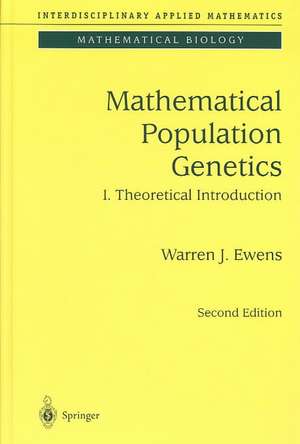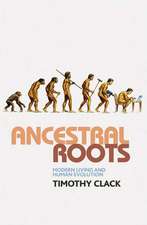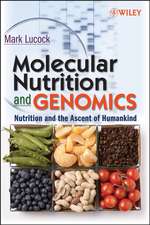Mathematical Population Genetics 1: Theoretical Introduction: Interdisciplinary Applied Mathematics, cartea 27
Autor Warren J. Ewensen Limba Engleză Hardback – 9 ian 2004
This is the first of a planned two-volume work discussing the mathematical aspects of population genetics, with an emphasis on the evolutionary theory. This first volume draws heavily from the author's classic 1979 edition, which appeared originally in Springer's Biomathematics series. It has been revised and expanded to include recent topics which follow naturally from the treatment in the earlier edition, e.g., the theory of molecular population genetics.
This book will appeal to graduate students and researchers in mathematical biology and other mathematically-trained scientists looking to enter the field of population genetics.
| Toate formatele și edițiile | Preț | Express |
|---|---|---|
| Paperback (1) | 896.84 lei 6-8 săpt. | |
| Springer – 29 noi 2010 | 896.84 lei 6-8 săpt. | |
| Hardback (1) | 1118.30 lei 6-8 săpt. | |
| Springer – 9 ian 2004 | 1118.30 lei 6-8 săpt. |
Din seria Interdisciplinary Applied Mathematics
- 15%
 Preț: 667.05 lei
Preț: 667.05 lei - 19%
 Preț: 420.87 lei
Preț: 420.87 lei - 20%
 Preț: 664.77 lei
Preț: 664.77 lei - 15%
 Preț: 980.97 lei
Preț: 980.97 lei - 17%
 Preț: 528.44 lei
Preț: 528.44 lei - 18%
 Preț: 908.71 lei
Preț: 908.71 lei - 18%
 Preț: 1006.38 lei
Preț: 1006.38 lei - 15%
 Preț: 659.67 lei
Preț: 659.67 lei -
 Preț: 498.14 lei
Preț: 498.14 lei -
 Preț: 528.35 lei
Preț: 528.35 lei - 15%
 Preț: 659.02 lei
Preț: 659.02 lei - 15%
 Preț: 480.52 lei
Preț: 480.52 lei -
 Preț: 390.63 lei
Preț: 390.63 lei - 18%
 Preț: 918.61 lei
Preț: 918.61 lei -
 Preț: 388.52 lei
Preț: 388.52 lei - 15%
 Preț: 647.92 lei
Preț: 647.92 lei - 15%
 Preț: 655.60 lei
Preț: 655.60 lei - 23%
 Preț: 734.80 lei
Preț: 734.80 lei - 15%
 Preț: 660.83 lei
Preț: 660.83 lei - 18%
 Preț: 967.08 lei
Preț: 967.08 lei -
 Preț: 809.10 lei
Preț: 809.10 lei -
 Preț: 403.91 lei
Preț: 403.91 lei - 18%
 Preț: 896.84 lei
Preț: 896.84 lei - 18%
 Preț: 1004.00 lei
Preț: 1004.00 lei - 18%
 Preț: 974.19 lei
Preț: 974.19 lei -
 Preț: 399.67 lei
Preț: 399.67 lei - 18%
 Preț: 1181.99 lei
Preț: 1181.99 lei
Preț: 1118.30 lei
Preț vechi: 1363.78 lei
-18% Nou
Puncte Express: 1677
Preț estimativ în valută:
213.98€ • 223.42$ • 177.10£
213.98€ • 223.42$ • 177.10£
Carte tipărită la comandă
Livrare economică 04-18 aprilie
Preluare comenzi: 021 569.72.76
Specificații
ISBN-13: 9780387201917
ISBN-10: 0387201912
Pagini: 418
Ilustrații: XX, 418 p.
Dimensiuni: 155 x 235 x 25 mm
Greutate: 0.72 kg
Ediția:2nd ed. 2004
Editura: Springer
Colecția Springer
Seria Interdisciplinary Applied Mathematics
Locul publicării:New York, NY, United States
ISBN-10: 0387201912
Pagini: 418
Ilustrații: XX, 418 p.
Dimensiuni: 155 x 235 x 25 mm
Greutate: 0.72 kg
Ediția:2nd ed. 2004
Editura: Springer
Colecția Springer
Seria Interdisciplinary Applied Mathematics
Locul publicării:New York, NY, United States
Public țintă
ResearchCuprins
1 Historical Background.- 1.1 Biometricians, Saltationists and Mendelians.- 1.2 The Hardy-Weinberg Law.- 1.3 The Correlation Between Relatives.- 1.4 Evolution.- 1.5 Evolved Genetic Phenomena.- 1.6 Modelling.- 1.7 Overall Evolutionary Theories.- 2 Technicalities and Generalizations.- 2.1 Introduction.- 2.2 Random Union of Gametes.- 2.3 Dioecious Populations.- 2.4 Multiple Alleles.- 2.5 Frequency-Dependent Selection.- 2.6 Fertility Selection.- 2.7 Continuous-Time Models.- 2.8 Non-Random-Mating Populations.- 2.9 The Fundamental Theorem of Natural Selection.- 2.10 Two Loci.- 2.11 Genetic Loads.- 2.12 Finite Markov Chains.- 3 Discrete Stochastic Models.- 3.1 Introduction.- 3.2 Wright-Fisher Model: Two Alleles.- 3.3 The Cannings (Exchangeable) Model: Two Alleles.- 3.4 Moran Models: Two Alleles.- 3.5 K-Allele Wright-Fisher Models.- 3.6 Infinitely Many Alleles Models.- 3.7 The Effective Population Size.- 3.8 Frequency-Dependent Selection.- 3.9 Two Loci.- 4 Diffusion Theory.- 4.1 Introduction.- 4.2 The Forward and Backward Kolmogorov Equations.- 4.3 Fixation Probabilities.- 4.4 Absorption Time Properties.- 4.5 The Stationary Distribution.- 4.6 Conditional Processes.- 4.7 Diffusion Theory.- 4.8 Multi-dimensional Processes.- 4.9 Time Reversibility.- 4.10 Expectations of Functions of Diffusion Variables.- 5 Applications of Diffusion Theory.- 5.1 Introduction.- 5.2 No Selection or Mutation.- 5.3 Selection.- 5.4 Selection: Absorption Time Properties.- 5.5 One-Way Mutation.- 5.6 Two-Way Mutation.- 5.7 Diffusion Approximations and Boundary Conditions.- 5.8 Random Environments.- 5.9 Time-Reversal and Age Properties.- 5.10 Multi-Allele Diffusion Processes.- 6 Two Loci.- 6.1 Introduction.- 6.2 Evolutionary Properties of Mean Fitness.- 6.3 Equilibrium Points.- 6.4 Special Models.- 6.5 Modifier Theory.- 6.6 Two-Locus Diffusion Processes.- 6.7 Associative Overdominance and Hitchhiking.- 6.8 The Evolutionary Advantage of Recombination.- 6.9 Summary.- 7 Many Loci.- 7.1 Introduction.- 7.2 Notation.- 7.3 The Random Mating Case.- 7.4 Non-Random Mating.- 7.5 The Correlation Between Relatives.- 7.6 Summary.- 8 Further Considerations.- 8.1 Introduction.- 8.2 What is Fitness?.- 8.3 Sex Ratio.- 8.4 Geographical Structure.- 8.5 Age Structure.- 8.6 Ecological Considerations.- 8.7 Sociobiology.- 9 Molecular Population Genetics: Introduction.- 9.1 Introduction.- 9.2 Technical Comments.- 9.3 Infinitely Many Alleles Models: Population Properties..- 9.4 Infinitely Many Sites Models: Population Properties.- 9.5 Sample Properties of Infinitely Many Alleles Models..- 9.6 Sample Properties of Infinitely Many Sites Models.- 9.7 Relation Between Infinitely Many Alleles and Infinitely Many Sites Models.- 9.8 Genetic Variation Within and Between Populations.- 9.9 Age-Ordered Alleles: Frequencies and Ages.- 10 Looking Backward in Time: The Coalescent.- 10.1 Introduction.- 10.2 Competing Poisson and Geometric Processes.- 10.3 The Coalescent Process.- 10.4 The Coalescent and Its Relation to Evolutionary Genetic Models.- 10.5 Coalescent Calculations: Wright-Fisher Models.- 10.6 Coalescent Calculations: Exact Moran Model Results.- 10.7 General Comments.- 10.8 The Coalescent and Human Genetics.- 11 Looking Backward: Testing the Neutral Theory.- 11.1 Introduction.- 11.2 Testing in the Infinitely Many Alleles Models.- 11.3 Testing in the Infinitely Many Sites Models.- 12 Looking Backward in Time: Population and Species Comparisons.- 12.1 Introduction.- 12.2 Various Evolutionary Models.- 12.3 Some Implications.- 12.4 Statistical Procedures.- Appendix A: Eigenvalue Calculations.- References.- Author Index.
Recenzii
From reviews of the 1979 edition:
"Here we have perhaps the most articulate of the many fine Australian population geneticists bringing us up to date on the mathematical aspects of his field." -B. S. Weir, William Neal Reynolds Professor of Statistics and Genetics, Director, Bioinformatics Research Center, North Carolina State University
"This book is an excellent source to learn the field for a mathematician or mathematically sophisticated reader." -SIAM Review
"An important reference to anyone interested in the mathematical aspects of population genetics, not only to those actually doing it, but to anyone trying to bridge the now substantial gap between theoretical and experimental population genetics." -The Quarterly Review of Biology
From the reviews of the second edition:
"It is the first of a planned two-volume sequence treating mathematical aspects of population genetics theory and its applications to evolution. … The presentation is very clear and the author confers many of his deep insights to the reader. Therefore, this new edition has very good prospects to serve as the most important introductory text to this active field of research … ." (R. Bürger, Monatshefte für Mathematik, Vol. 145 (1), 2005)
From the reviews of the second edition:
"This book is an extensively revised and expanded second edition … . It presents the principles of mathematical population genetics with an emphasis on evolutionary theory. … Ewens presentation bridges marvellously mathematics and biology. The author effectively copes with the problem that mathematicians want to see technical details, while biologists do not like formalism." (Martin Möhle, Zeitschrift für Angewandte Mathematik und Mechanik, Vol. 85 (1), 2005)
From the reviews of the second edition:
"The book concentrates on the mathematical aspects of population genetics at the graduate or researchlevel. … an excellent summary of the most important results, and very welcome in view of a vast scattered literature. I particularly like the many interesting connections that are made … . Another highlight is an extra chapter on Moran model … . Ewens’ account of mathematical population genetics is unique … . I am very happy to see this second edition in print … ." (Ellen Baake, Mathematical Biosciences, Vol. 197, 2005)
"This is an excellent book on population genetics and evolution placing the emphasis on mathematical and statistical aspects of the theory. … the author successfully connects classical prospective theory with the current retrospective viewpoint of population genetics. … this is an exciting and significant book which reflects the author’s enthusiasm and experience in the field through many decades. It should be read by graduate students and researchers interested in mathematical aspects of population genetics … ." (Günther Karigl, Zentralblatt MATH, Vol. 1060, 2005)
"This book is in a series of texts specializing in interdisciplinary applied mathematics and is scheduled as the first volume of two devoted to population genetics by the same author; it is the second edition of the book first published in 1979. … This book will be of most use to postgraduate researchers … . the book under review admirably sets the scene by including a discussion of the broad theories of population dynamics." (Tony Crilly, The Mathematical Gazette, Vol. 89 (516), 2005)
"Here we have perhaps the most articulate of the many fine Australian population geneticists bringing us up to date on the mathematical aspects of his field." -B. S. Weir, William Neal Reynolds Professor of Statistics and Genetics, Director, Bioinformatics Research Center, North Carolina State University
"This book is an excellent source to learn the field for a mathematician or mathematically sophisticated reader." -SIAM Review
"An important reference to anyone interested in the mathematical aspects of population genetics, not only to those actually doing it, but to anyone trying to bridge the now substantial gap between theoretical and experimental population genetics." -The Quarterly Review of Biology
From the reviews of the second edition:
"It is the first of a planned two-volume sequence treating mathematical aspects of population genetics theory and its applications to evolution. … The presentation is very clear and the author confers many of his deep insights to the reader. Therefore, this new edition has very good prospects to serve as the most important introductory text to this active field of research … ." (R. Bürger, Monatshefte für Mathematik, Vol. 145 (1), 2005)
From the reviews of the second edition:
"This book is an extensively revised and expanded second edition … . It presents the principles of mathematical population genetics with an emphasis on evolutionary theory. … Ewens presentation bridges marvellously mathematics and biology. The author effectively copes with the problem that mathematicians want to see technical details, while biologists do not like formalism." (Martin Möhle, Zeitschrift für Angewandte Mathematik und Mechanik, Vol. 85 (1), 2005)
From the reviews of the second edition:
"The book concentrates on the mathematical aspects of population genetics at the graduate or researchlevel. … an excellent summary of the most important results, and very welcome in view of a vast scattered literature. I particularly like the many interesting connections that are made … . Another highlight is an extra chapter on Moran model … . Ewens’ account of mathematical population genetics is unique … . I am very happy to see this second edition in print … ." (Ellen Baake, Mathematical Biosciences, Vol. 197, 2005)
"This is an excellent book on population genetics and evolution placing the emphasis on mathematical and statistical aspects of the theory. … the author successfully connects classical prospective theory with the current retrospective viewpoint of population genetics. … this is an exciting and significant book which reflects the author’s enthusiasm and experience in the field through many decades. It should be read by graduate students and researchers interested in mathematical aspects of population genetics … ." (Günther Karigl, Zentralblatt MATH, Vol. 1060, 2005)
"This book is in a series of texts specializing in interdisciplinary applied mathematics and is scheduled as the first volume of two devoted to population genetics by the same author; it is the second edition of the book first published in 1979. … This book will be of most use to postgraduate researchers … . the book under review admirably sets the scene by including a discussion of the broad theories of population dynamics." (Tony Crilly, The Mathematical Gazette, Vol. 89 (516), 2005)
Textul de pe ultima copertă
Population genetics occupies a central role in a number of important biological and social undertakings. It is fundamental to our understanding of evolutionary processes, of plant and animal breeding programs, and of various diseases of particular importance to mankind. This is the first of a planned two-volume work discussing the mathematical aspects of population genetics, with an emphasis on the evolutionary theory. This first volume draws heavily from the author's classic 1979 edition since the material in that edition may be taken, to a large extent, as introductory to the contemporary theory. It has been revised and expanded to include recent topics that follow naturally from the treatment in the earlier edition, e.g., the theory of molecular population genetics and coalescent theory.
This book will appeal to graduate students and researchers interested in theoretical population genetics and evolution.
Reviews of the first edition:
Ewens book will be an important reference to anyone interested in the mathematical aspects of population genetics, not only to those actually doing it, but also to anyone trying to bridge the now substantial gap between theoretical and experimental population genetics.
Woodrow Setzer, Quarterly Review of Biology, 1980
This book is an excellent combination of an introduction to population genetics theory for a mathematically sophisticated reader, together with a survey of current work in the field.
Stanley Sawyer, SIAM Review, 1980
Caracteristici
New, expanded edition of a well-known and highly-regarded classic that originally appeared in Springer's Biomathematics series in 1979 Includes supplementary material: sn.pub/extras














